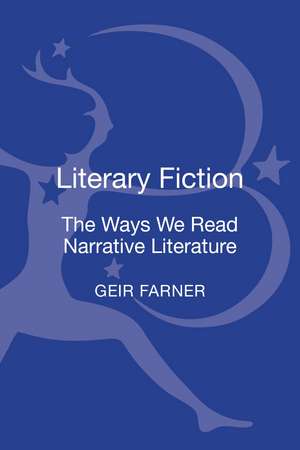Literary Fiction: The Ways We Read Narrative Literature
Autor Professor Geir Farneren Limba Engleză Hardback – 26 mar 2014
| Toate formatele și edițiile | Preț | Express |
|---|---|---|
| Paperback (1) | 239.59 lei 6-8 săpt. | |
| Bloomsbury Publishing – 26 mar 2014 | 239.59 lei 6-8 săpt. | |
| Hardback (1) | 833.06 lei 6-8 săpt. | |
| Bloomsbury Publishing – 26 mar 2014 | 833.06 lei 6-8 săpt. |
Preț: 833.06 lei
Preț vechi: 1066.32 lei
-22% Nou
Puncte Express: 1250
Preț estimativ în valută:
159.41€ • 170.46$ • 132.91£
159.41€ • 170.46$ • 132.91£
Carte tipărită la comandă
Livrare economică 18 aprilie-02 mai
Preluare comenzi: 021 569.72.76
Specificații
ISBN-13: 9781623564841
ISBN-10: 1623564840
Pagini: 336
Dimensiuni: 140 x 216 x 28 mm
Greutate: 0.57 kg
Ediția:New.
Editura: Bloomsbury Publishing
Colecția Bloomsbury Academic
Locul publicării:New York, United States
ISBN-10: 1623564840
Pagini: 336
Dimensiuni: 140 x 216 x 28 mm
Greutate: 0.57 kg
Ediția:New.
Editura: Bloomsbury Publishing
Colecția Bloomsbury Academic
Locul publicării:New York, United States
Caracteristici
Accessible guide to theories on reading and interpretation, especially of narrative fiction
Notă biografică
Geir Farner is Professor of Dutch language and literature in the Department of Literature, Area Studies and European Languages (ILOS) at the University of Oslo, Norway.
Cuprins
1. Introduction2. What is literary fiction?3. The fictional communication process4. The cognitive and aesthetic dimensions of literature5. The limits of the literary work 6. Intention and message7. Problems related to the sender 8. The structure of the action 9. Selection10. Voice11. Viewpoint, focalization12. Frequency13. Order14. Suspense15. The functions of literary fiction16. Evaluation17. ConclusionBibliographyIndex
Recenzii
With examples taken from a variety of national literatures, Literary Fiction patiently revisits all the basic notions in narrative theory. Farner's observations are astute, and his solutions provocative. Chapters on suspense and the evaluative component in interpretation provide the icing on the cake.
An engaging read, Farner's Literary Fiction is an exhaustive retelling of the development of the various schools of literary criticism, from post-WW II domination of New Criticism through the wave of semioticians, political ideologues, and then finally the post-postmodernists, who see literary criticism as a rainbow palette from which one may blend critical approaches. The volume presents a rewarding continental perspective of modern "lit crit." The book will prove useful as a backgrounder or as a brief refresher. Summing Up: Recommended. Upper-division undergraduates through faculty.
What can a linguist do for Americanist literary critics? Plenty. As a rhetorician and cognitivist, Geir Farner brings more sources to bear on literary study than does the usual linguist. He offers not only revisions of old theories, but also shows how literary fiction communicates and what it communicates. As such, these new arguments bridge gaps between narratology in general, and cognitive theory in particular. . Clear and original, Farner's study comprises an important argument in narratology and cognitive theory. . [T]his study will be helpful for a wide range of readers-from advanced students through senior scholars. In particular, Americanist literary critics and rhetoricians who are interested in narratology's application to historicist and feminist matters will benefit from this study. And so will cultural and intellectual historians studying historiography, for this work is probably the most relevant exploration of literary form's influence on narrative since Hayden White's Metahistory (1973), The Content of the Form (1987), and Figural Realism (1999). As such, this work deserves a high place on the Parnassus of American Studies.
An engaging read, Farner's Literary Fiction is an exhaustive retelling of the development of the various schools of literary criticism, from post-WW II domination of New Criticism through the wave of semioticians, political ideologues, and then finally the post-postmodernists, who see literary criticism as a rainbow palette from which one may blend critical approaches. The volume presents a rewarding continental perspective of modern "lit crit." The book will prove useful as a backgrounder or as a brief refresher. Summing Up: Recommended. Upper-division undergraduates through faculty.
What can a linguist do for Americanist literary critics? Plenty. As a rhetorician and cognitivist, Geir Farner brings more sources to bear on literary study than does the usual linguist. He offers not only revisions of old theories, but also shows how literary fiction communicates and what it communicates. As such, these new arguments bridge gaps between narratology in general, and cognitive theory in particular. . Clear and original, Farner's study comprises an important argument in narratology and cognitive theory. . [T]his study will be helpful for a wide range of readers-from advanced students through senior scholars. In particular, Americanist literary critics and rhetoricians who are interested in narratology's application to historicist and feminist matters will benefit from this study. And so will cultural and intellectual historians studying historiography, for this work is probably the most relevant exploration of literary form's influence on narrative since Hayden White's Metahistory (1973), The Content of the Form (1987), and Figural Realism (1999). As such, this work deserves a high place on the Parnassus of American Studies.












